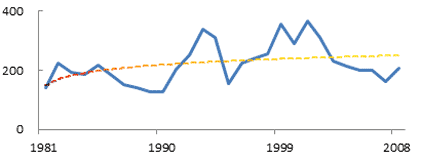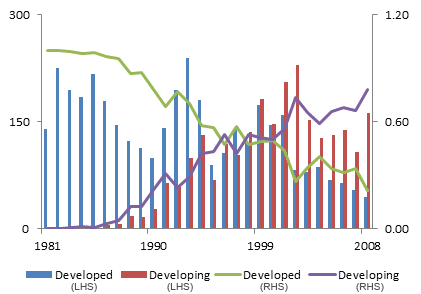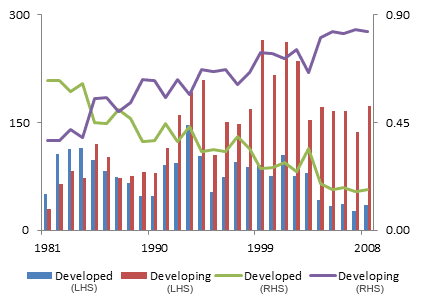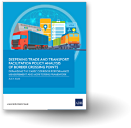Global antidumping and the People’s Republic of China
Anti-dumping (AD) investigations are widespread. According to a WTO Report, from 1995 to 2008, there were 43 countries that launched a total of 3427 investigations against 100 countries. Antidumping has fluctuated cyclically but the total number of filings increased between 1981 and 2008 (Figure 1). The pattern of AD filings changed significantly over this period. On the one hand, developing countries have now become heavy AD users. In the early 1980s almost all AD fillings were initiated by developed countries and even in the early 1990s developing countries accounted for only about 20 percent of the total AD filings. But in 2008, the corresponding figure was close to 80 per cent of the total number of AD investigations reported (Figure 2). On the other hand, developing countries remain the main target of the global AD investigations. AD filings against developing exporters accounted for 54 percent of total AD filings between 1981-1994. However, the ratio increased to 73 per cent on average during 1995-2008 (Figure 3).
Figure 1. Antidumping Initiations During 1981-2008

Source: WTO Report
Figure 2. Antidumping Initiations By Country Groups

Note: LHS = left-hand side axis; RHS = right-hand side axis
Source: Based on the authors’ calculation.
Figure 3. Antidumping Targets By Country Groups

Note: LHS = left-hand side axis; RHS = right-hand side axis
Source: Based on the authors’ calculation.
Why has antidumping proliferated? Evidence shows that economic incentives, strategic considerations and the existence of contagion effects influence many countries’ decisions to initiate AD investigations. In particular, slower GDP growth, currency appreciation and higher import penetration result in more AD filings. Importing countries tend to initiate more AD investigations when they themselves encounter more AD filings due to either tit-for-tat or general retaliation incentives, and they tend to initiate more AD investigations against those economies which rely heavily on AD themselves. However, importing countries are less likely to initiate AD filings against other countries with a higher potential for retaliation, e.g. if the latter’s market is an important export market for the former. Furthermore, AD spreads through different types of contagion, such as trade deflection, echoing and trade diversion.
What about the experience of the PRC? At the global level, there are two distinct features. First, as the largest "defendant" in the world, the PRC has been increasingly targeted by AD filings. Between 1981 and 1994, the PRC ranked 3rd among targeted countries, second only to America and Japan, subjected to 186 AD filings accumulatively, and representing 6.9% of international AD filings. Between 1995 and 2008, the PRC remained the top target every year, facing 19.8% of total AD filings on average. Second, severe asymmetries exist for the PRC as plaintiff and defendant in recent global AD investigations (Figure 4). From 1995 to 2008, the PRC was subject to 677 AD investigations while it launched only 151 AD investigations itself.p>
Figure 4. The PRC’s Asymmetric Position In Global Antidumping

Source: Based on the authors’ calculation.
At the bilateral level, antidumping cases involving the PRC seem "different" from cases involving other AD targets. According to statistical analysis done by Bown and McCulloch (2005) and Bown (2010), the use of AD by the US against the PRC seems to have been distinctively biased during its pre-WTO accession period of 1995-2001. First, the PRC was the largest target of US antidumping actions despite being only the fifth largest exporter with 8 percent of the US import market. Second, the PRC was the only named country in 42 percent of the investigations that its exporters faced, while the average across all cases was 20 percent. Third, half of the US investigations against the PRC resulted in the imposition of a final antidumping measure; Finally, AD duties imposed on the PRC are almost twice as high as those imposed across all investigated countries.
Being a WTO Member since 2002, the PRC has been on an equal footing with other Members in terms of resolving disputes through the WTO’s dispute settlement procedures. However, this does not seem to have helped to reduce AD filings from traditional AD users. The use of AD by the US against the PRC has not differed systematically from the period prior to and the period following the PRC’s accession to the WTO. As for the other three traditional AD users, EU, Canada, and Australia, they also treat Chinese exports differently to those of other countries. The overall number of filings seems to be decreasing but the proportion targeting the PRC is increasing. Worse still, new AD users such as India have increased the use of AD against the PRC.
Further research is needed to analyze global antidumping trends. Research focusing on the PRC is particularly urgent since the PRC has emerged as the world’s largest exporter and the world’s second largest importer. There are several possible reasons why the PRC has been so heavily targeted and has been treated differently. The PRC is such a massive exporter and has such massive cost advantages over competitors, especially in some politically sensitive sectors which resulted in AD actions imposed by the US and the EU in particular. Another possibility is that there might be some degree of discrimination against the PRC partly due to the perception that it is less likely to itself use AD to retaliate.




